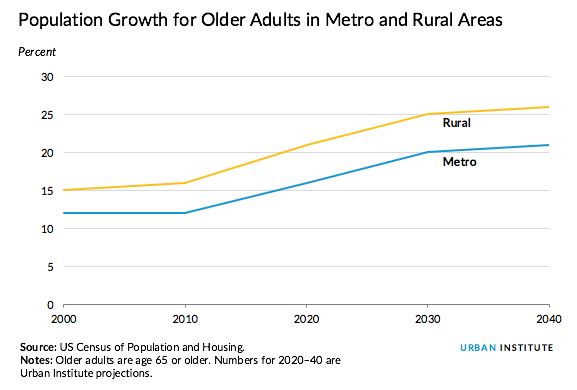 Over the next 15 years, urban and rural communities in the United States will both see their populations grow. The difference is that in rural areas, the increase will be mostly elderly citizens.
Over the next 15 years, urban and rural communities in the United States will both see their populations grow. The difference is that in rural areas, the increase will be mostly elderly citizens.
That’s according to a new study from the Urban Institute, which also made the point that it’s not just people who are aging in rural America, it’s the houses themselves. The institute said that rural housing stock is already much older than that found in cities and as a result is not especially friendly to populations that will be aging in place.
“The bottom line,” the report stated, is that “we are not ready to house people safely and adequately in our rapidly aging rural communities.”
According to the report, rural America is barely growing but rapidly aging. Between 2010 and 2020, rural populations will grow by just 2 percent, while urban populations will increase by 9 percent; the institute reported. However, between 2020 and 2030; rural population growth will slow to just 1 percent, while urban populations will grow by 8 percent. And it just gets more exaggerated from there.
Moreover, demand will not necessarily decrease just because of slow growth. The average person today lives longer and is more independent than in past generations, but “a house deteriorates with time, so new housing must be built or existing housing rehabilitated,” the report stated.
 While new construction is good for jobs and built-in benefits and features, older homes are often built strong and spacious and can be retrofitted for aging-in-place populations. And rural communities tend to have more older structures than cities, which regularly see old buildings razed in favor of new construction. This, the institute said, makes getting into those older rural houses an urgent issue.
While new construction is good for jobs and built-in benefits and features, older homes are often built strong and spacious and can be retrofitted for aging-in-place populations. And rural communities tend to have more older structures than cities, which regularly see old buildings razed in favor of new construction. This, the institute said, makes getting into those older rural houses an urgent issue.
The institute outlined four ways to help meet the needs of the growing rural elderly population: increasing labor force training to properly rehabilitate the old housing stock in rural America to today’s standards; ensure that capital is available for rehabilitation and not just new construction through new sources of financing and government subsidies; encouraging seniors to move to smaller, newer homes and take advantage of government programs and private-sector actions to do so; and expanding home equity programs.
“The entire country needs to prepare to adequately and affordably house the large number of aging baby boomers, but the loss of younger households in rural areas means rural areas will feel the effects first,” the report said. “Caring for our seniors requires us to renew planning and investment in rural areas.”

 theMReport.com Your trusted source for mortgage banking news
theMReport.com Your trusted source for mortgage banking news








